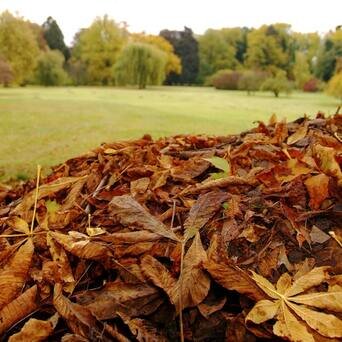Use Leaves To Fertilize Your Yard Rather Than Having Them Taken Away
What to Do With Fallen Leaves
When trees lose their leaves in the fall, there are many things that can be done with them to add value to your property rather than having the city pick them up. When forest managers, arborists and landscape architects work with trees, they mimic natural processes as closely as possible for the healthiest plant conditions. Homeowners can do the same to make the most of an annual occurrence.
When leaves are picked up and taken away, it tends to deplete the property’s soil of the natural nutrients and organisms that make a healthy topsoil. Putting the leaves back into the soil recycles the essential minerals and material that were consumed by the tree, which will be available again after decay.
Building Soil
In nature, leaves fall to the ground and decompose at their own pace. The shaded woodland doesn’t normally have grass, so leaves don’t disturb any vegetation below the trees. In urban areas, however, grassy lawns are often an important feature in neighborhood yards. If you’re worried about leaves hurting the appearance of your lawn, leaves can be raked under or behind bushes for storage, or in any area where grass isn’t growing. Once they’re collected, leaves can be used to fertilize the grass by passing a mower over them, speeding up the decomposition process, allowing the grass to breathe and building the soil underneath.
Leaves can also be used as mulch around trees or in gardens. Leaves are a good material for mulch because they are light, decompose quickly and are readily available. By putting pine straw over the leaves to keep them in place, together these light, biodegradable materials allow oxygen and water to enter and help decomposition, rather than packing too tightly and cutting off air. Typical denser mulches don’t allow air movement, creating a space where funguses can grow and damage the roots or base of a tree. Tree roots are at the surface level of the ground and need oxygen, so be sure to spread mulch out and not apply too thick of a layer so the tree can breathe.
For the same reasons that leaves are good mulch material, they are also an excellent additive for compost. Composting is a process of collecting organic waste materials to biodegrade and use as humus, or bioactive soil material. This supports a healthy and lively topsoil, where earthworms and many other very small animals (microorganisms) live and make minerals and nutrients available to plants through their roots. A quick search online will show the most appropriate ways to go about composting and using leaves as part of the process.
Valuing Fallen Leaves
If you think of leaves as soil-builders, they become a valuable (and free) product rather than a nuisance. Looking at the whole system shows that leaves become soil and soil becomes leaves; they are interdependent on one another. Keeping leaves on the property, preferably under the trees they are from, contributes to the soil and the plants growing there. It also adds to a community’s ecosystem wealth since robust soils can grow healthy trees, each of which is an individual contribution to a productive canopy.


